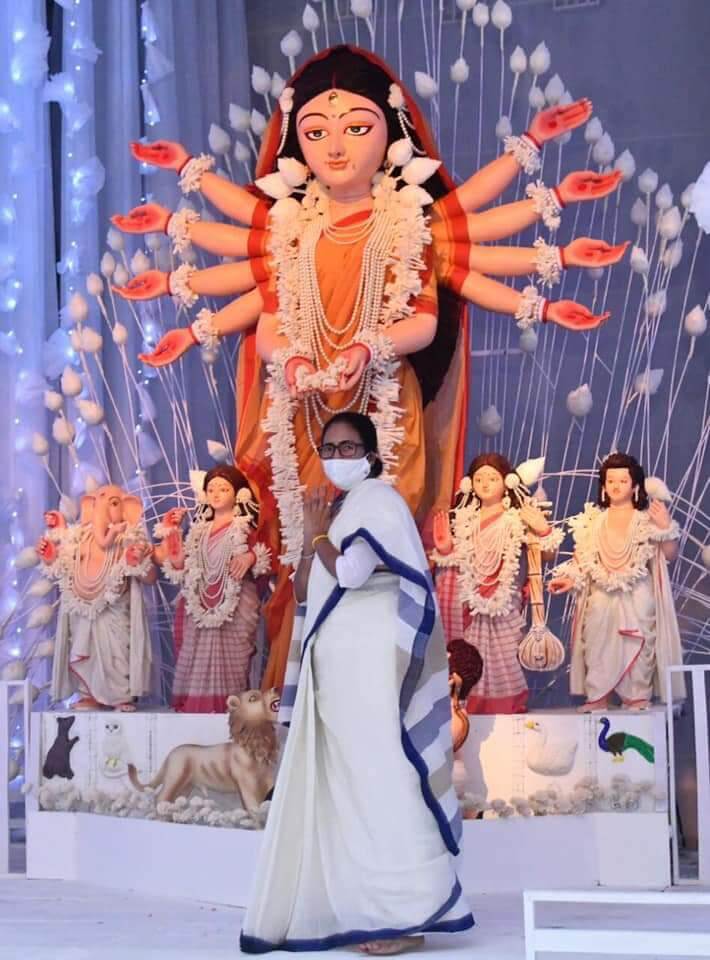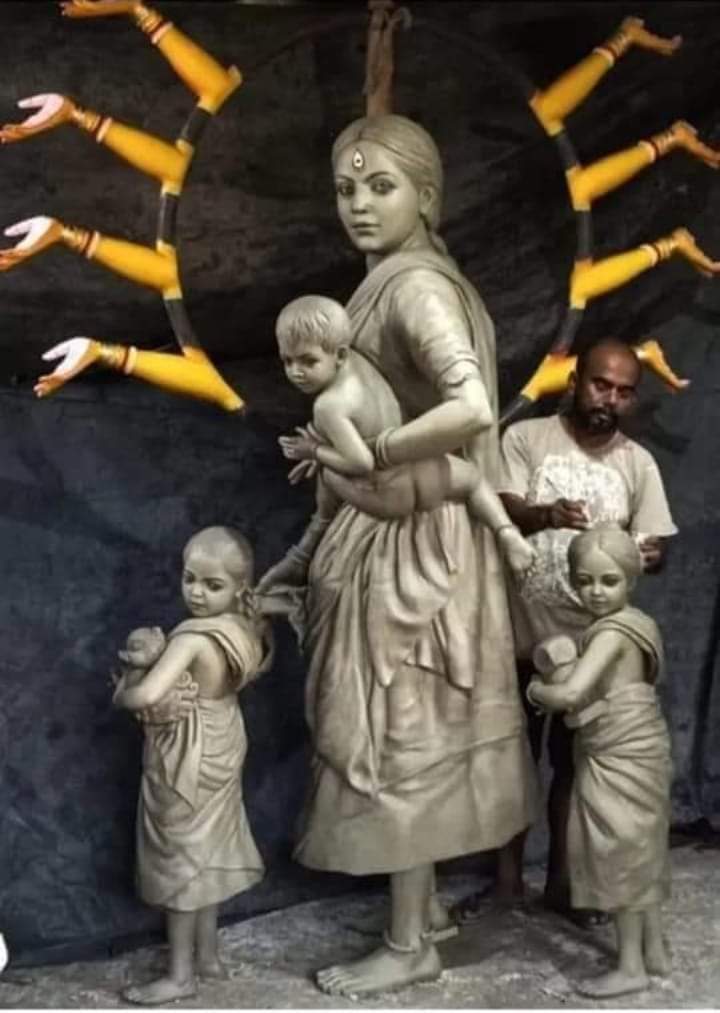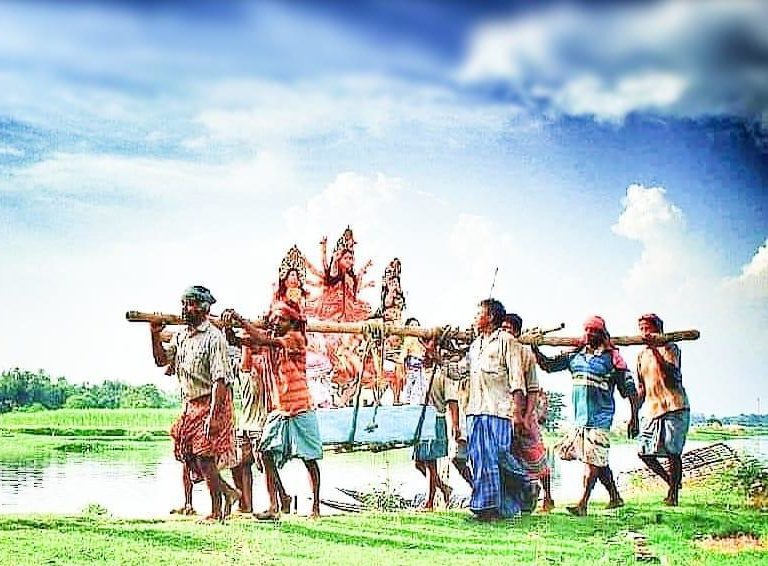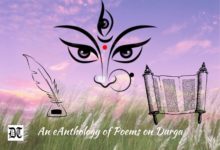Throwing caution to wind, Mamata Banerjee sought to appease the Hindus to counter the Right-wing dent on her vote bank. Assembly elections are round the corner. Calcutta High Court intervened for the safety of the commoners. An analysis by Shyamal, as Special Feature, exclusively for Different Truths.

With an apology to Sant Kabir:
Devi khadi kanooni bazar mein, bairi hui nyayalay
Vakil unki sarkari, bhaktjan bane ashay
With the unwrapping of current happenings in the country, the Divine Grace has been crestfallen on the floor of His Lordships, where He/She has been summoned as litigant persona – be it to decide gender discrimination of the devotees, to adjudicate the birthplace of deity, or to restrain devotees Darshan of the idol from close proximity. It is the judiciary saranam gachcha (Redeemer).
The festival of invoking Maa Durga (popularly known as Sarodotsav) bears an umbilical cord to the people and residents of the Bengal – the Bangalis: the singularly exuberant Bangaliyana by tradition. Aswin, a month (mid-September to mid-October) of autumn arrives, when cotton flake like cloud gliding around the blue sky, when Kash ( tall alley grasses) flowers blooming in abundance when high pitched beat from Dhak ( drum) resonating in the air and our heart wafting with pleasantly cool atmosphere. It is then the Goddess Durga accompanied with her children begins her journey of homecoming during the holy fortnight – Devipaksha. The invocation rituals of the Ma Durga begin on the sixth of Aswin full moon fortnight (Mahasasthi) and are being performed till the tenth day of the fortnight (Vijaya Dashami) ending with the immersion of the idols into the river.
The invocation of the Goddess Durga had its root in the ancient Purana as a symbol of the omnipotent Adi Shakti but it used to be worshipped during the spring month of Chaitra fortnight of the full moon as Ma Basanti. The current calendar of Puja festival, also named Akal Bodhan, as per folklores had been initiated by Raja Kansnarayan of Taherpur (some say it is the Raja of Dinajpur) during the Moghul rule in the later years of 1500 A.D. Thereafter, the landlord from Barisha, the swabarna (high caste) Roychowdhury began to worship Ma Durga, since 1610 A.D.
In the initial years, the Puja used to be celebrated in the household of the wealthy or the rich landlords to exhibit their opulence to the British rulers – many of the British officials would enjoy as invitees with the special entertainment programmes in their honour. The community worship called Baroyari Puja (twelve friends) was the first public celebration, organised in 1910, by a group at Baghbazar
In the initial years, the Puja used to be celebrated in the household of the wealthy or the rich landlords to exhibit their opulence to the British rulers – many of the British officials would enjoy as invitees with the special entertainment programmes in their honour. The community worship called Baroyari Puja (twelve friends) was the first public celebration, organised in 1910, by a group at Baghbazar and now becomes popular as Sarbojanin (every persons’) Puja at public places with contributions as well as the participation of the community. With the passing of years, what used to be a pure orthodox way of celebration transformed into commercial pomp and showmanship, barring domestic and few communities worships like Baghbazar Pujas.

As it is most likely, any festival or celebration with mass appeal and participation has political ramifications, expected to implore the multitude of voters. As a matter of fact, the link of Puja festivals with the political programmes had been established during the pre-independence years, as a cover to misguide the British rulers. But after independence, barring few early years, the mass celebrations have become a jamboree of political muscle powers, where political leaders become covert patrons. Obviously, following tussle of power centres, the Puja committee and the Divinity are occasionally dragged to the Temple of the Justice.
In early 2021, West Bengal is scheduled to go for the Assembly election and the ruling dispensation has much to worry this time with the Right-wing brigade already denting the vote bank. With a couple of months left before the election schedule is announced, the Durga Puja is a godsent channel for party propaganda and public relations
In early 2021, West Bengal is scheduled to go for the Assembly election and the ruling dispensation has much to worry this time with the Right-wing brigade already denting the vote bank. With a couple of months left before the election schedule is announced, the Durga Puja is a godsent channel for party propaganda and public relations. Mamata Banerjee, the party supremo and the chief minister, in a calculated strategy to offset her minority appeasement image, announced in the month of September 2020, a state government allowance of Rs. 1000 /- per month and free house from government scheme for 8000 Hindu priests. On a subsequent announcement, she sanctioned Rs. 50,000/- to each of the 37,000 Puja Committees in the State. Added to it 50% concession in electricity bill and waiver of all permissions statutory also she conceded.

From October 14, 2020, Banerjee has been on a pandal-hopping spree. She continues to inaugurate Puja in different parts of the city; an act though popular to her image but in consequence, afterwards has warranted massive uncontrolled crowd assemblies within the pandals. All Covid protocols were blatantly flouted. Under a crazy and alarming situation forthcoming, a division bench of Calcutta High Court, responding to an application, on October 19 passed an order – to summarise it:
1) Each puja pandal is declared as a No Entry Zone and no devotee or visitor will be allowed inside pandal as a viewer or otherwise
2) The area of no entry will be 5 meters for smaller and10 meters for big pandals
3) Only organisers will be allowed inside: 25 for smaller and 50 for big pujas.
In a separate order from another bench, it has been ad interim stipulated that the grant money of 50,000/- from public exchequer must be used for purchases relating to masks, shields, sanitisers, with proper vouchers for audit and 25% may be used on non-entertainment public awareness activities.
We have quite often, in recent years, come across instances when the judiciary had to intervene to set right legislative logjam, to adjudicate failure of law and order, a matter of religious faiths. Even this very Calcutta High Court order ought to have been initiated from the state administration or the police. But these two administrative wings failed miserably.
The judicial intervention in the domain of administration or for that matter judicial outreach deactivates the checks and balances in any democratic setup and causes an apparent point of conflict. We have quite often, in recent years, come across instances when the judiciary had to intervene to set right legislative logjam, to adjudicate failure of law and order, a matter of religious faiths. Even this very Calcutta High Court order ought to have been initiated from the state administration or the police. But these two administrative wings failed miserably.
In the process, we find a few chips as how the public, who paid subscriptions, who are devotees to the idol, whose money indirectly doled by government stands restrained from entry and is also different from the organisers numbering 25/50? Why the pomp and extravaganza aren’t made to curtail beyond a limit? Why the concerned authorities are not taken to task even stricter (when there is live instance from Kerala and the spurt in Covid infections post-Onam festivals) for most irresponsible steps in the name of falling livelihoods.
The state by now on record has around 3,30,000 affected persons with daily additions. The popular adage, “A hangman`s rope always support the hanged”, comes to mind. It would be inappropriate not to blame the oppositions – the right-winger too has organised a celebration of puja fully aware of Centre`s advisory and otherwise awaiting to gain on the ruling party`s folly.

The state by now on record has around 3,30,000 affected persons with daily additions. The popular adage, “A hangman`s rope always support the hanged”, comes to mind. It would be inappropriate not to blame the oppositions – the right-winger too has organised a celebration of puja fully aware of Centre`s advisory and otherwise awaiting to gain on the ruling party`s folly. The left-winger and ally desire to fish in the already troubled political waters.
In such a scenario, the judiciary is hailed by the people as ultimate saviour, a role it has to abhor for itself. With the increasing data on infection during the days, post court order justifies the veracity of the sanctions imposed. An appeal is preferred on behalf of the Puja committees but rejected. In fact, the dilution of the order will be at the perils of the common people, often a bait in the big political game – the election.
Prasida Visveswari Pahi Viswam.
Photos sourced by the author from the Internet






 By
By
 By
By